 Technology peripherals
Technology peripherals
 AI
AI
 Only 10% of the parameters are needed to surpass SOTA! Zhejiang University, Byte, and Hong Kong Chinese jointly proposed a new framework for the 'category-level pose estimation' task
Only 10% of the parameters are needed to surpass SOTA! Zhejiang University, Byte, and Hong Kong Chinese jointly proposed a new framework for the 'category-level pose estimation' task
Only 10% of the parameters are needed to surpass SOTA! Zhejiang University, Byte, and Hong Kong Chinese jointly proposed a new framework for the 'category-level pose estimation' task
Giving robots a 3D understanding of everyday objects is a major challenge in robotics applications.
When exploring in an unknown environment, existing object pose estimation methods are still unsatisfactory due to the diversity of object shapes.
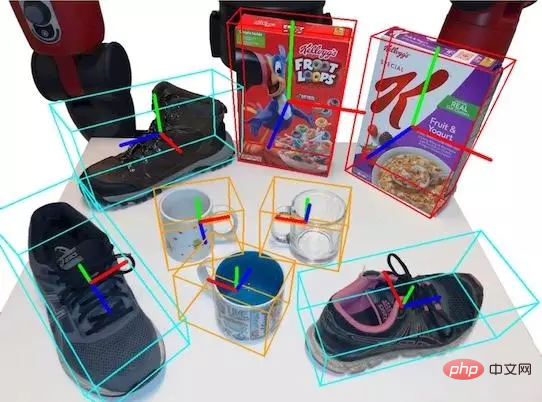
Recently, researchers from Zhejiang University, ByteDance Artificial Intelligence Laboratory and the Chinese University of Hong Kong jointly proposed a new framework for Category-level object shape and pose estimation from a single RGB-D image.

##Paper address: https://arxiv.org/abs/2210.01112
Project link: https://zju3dv.github.io/gCasp
In order to handle the shape changes of objects within categories, researchers Adopting a semantic primitive representation to encode different shapes into a unified latent space, this representation is the key to establishing reliable correspondence between observed point clouds and estimated shapes.
Then by designing a shape descriptor that is invariant to rigid body similarity transformation, the shape and pose estimation of the object are decoupled, thereby supporting any pose. Implicit shape optimization of target objects. Experiments show that the proposed method achieves leading pose estimation performance in public datasets.
Research backgroundIn the field of robot perception and operation, estimating the shape and pose of daily objects is a basic function and has a variety of applications, including 3D scene understanding, robotic operations and autonomous warehousing.
Early work on this task mostly focused on instance-level pose estimation, which mainly obtains the object pose by aligning the observed object with a given CAD model.
However, such a setup is limited in real-world scenarios because it is difficult to obtain an exact model of any given object in advance.
To generalize to unseen but semantically familiar objects, category-level object pose estimation is attracting increasing research attention because it can potentially handle real Various instances of the same category in the scene.
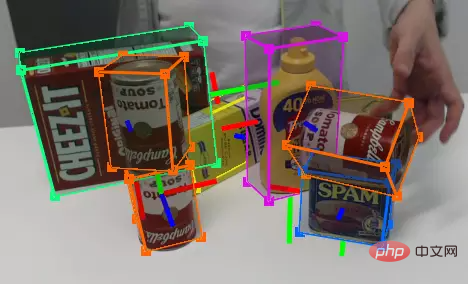
#Existing class-level pose estimation methods usually try to predict the pixel-level normalized coordinates of instances in a class, or use deformed Refer to the prior model to estimate the object pose.
Although these works have made great progress, these one-shot prediction methods still face difficulties when there are large shape differences in the same category.
In order to handle the diversity of objects within the same category, some works utilize neural implicit representation to adapt to the shape of the target object by iteratively optimizing the pose and shape in the implicit space, and Better performance was obtained.
There are two main challenges in class-level object pose estimation. One is the huge intra-class shape difference, and the other is the existing methods that couple shape and pose together. Optimization can easily lead to more complex optimization problems.
In this paper, researchers decouple the shape and pose estimation of objects by designing a shape descriptor that is invariant to rigid body similarity transformations, thereby supporting arbitrary poses Implicit shape optimization of target objects. Finally, the scale and pose of the object are solved based on the semantic association between the estimated shape and the observation.
Algorithm introductionThe algorithm consists of three modules, Semantic primitive extraction, Generative shape estimationandObject pose estimation.
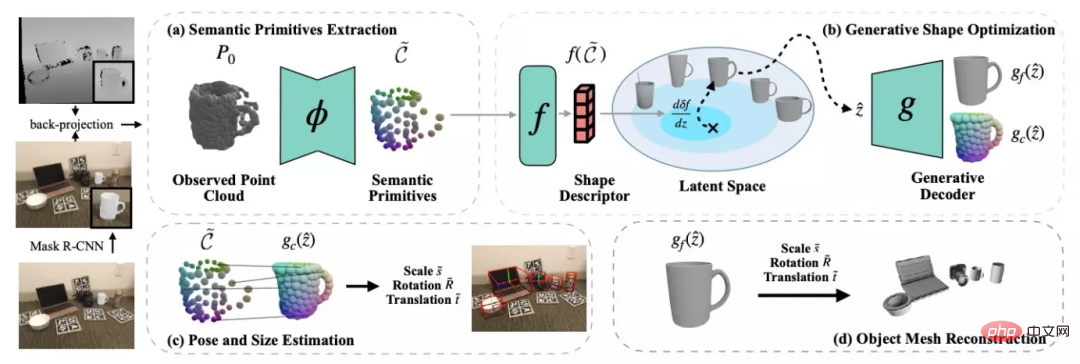
The input of the algorithm is a single RGB-D image. The algorithm uses the pre-trained Mask R-CNN to obtain the semantic segmentation results of the RGB image, and then back-projects the point cloud of each object based on the camera internal parameters. This method mainly processes point clouds and finally obtains the scale and 6DoF pose of each object.
Semantic primitive extraction
DualSDF[1] proposes a representation method of semantic primitives for similar objects. As shown on the left side of the figure below, in the same type of object, each instance is divided into a certain number of semantic primitives, and the label of each primitive corresponds to a specific part of a certain type of object.
In order to extract the semantic primitives of objects from the observation point cloud, the author utilizes a point cloud segmentation network to segment the observation point cloud into semantic primitives with labels.
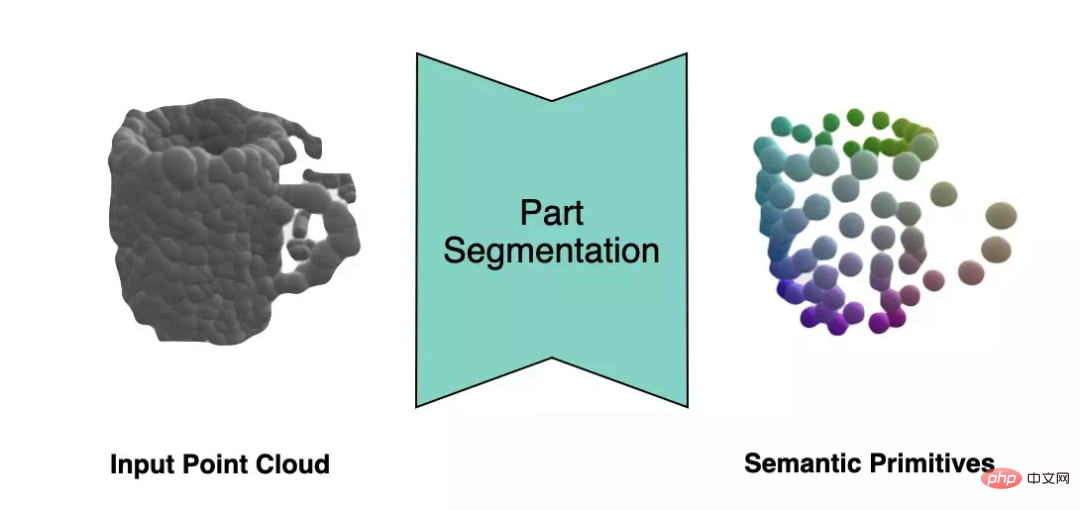
Generative shape estimation
3D generative model (such as DeepSDF) mostly operates in a normalized coordinate system.
However, there will be a similar pose transformation (rotation, translation and scale) between the object in the real world observation and the normalized coordinate system.
In order to solve the normalized shape corresponding to the current observation when the pose is unknown, the author proposes a shape descriptor that is invariant to similar transformations based on semantic primitive representation.
This descriptor is shown in the figure below, which describes the angle between vectors composed of different primitives:
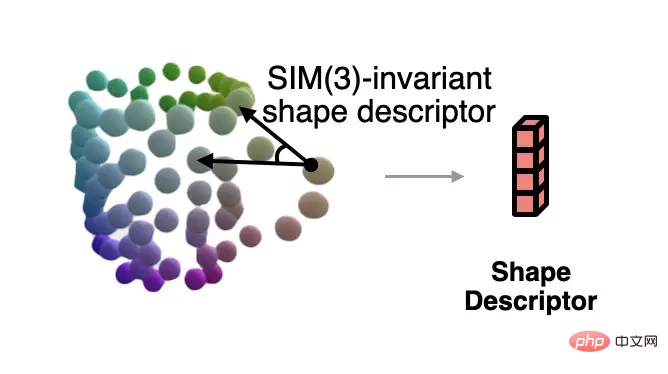
The author uses this descriptor to measure the error between the current observation and the estimated shape, and uses gradient descent to make the estimated shape more consistent with the observation. The process is shown in the figure below.
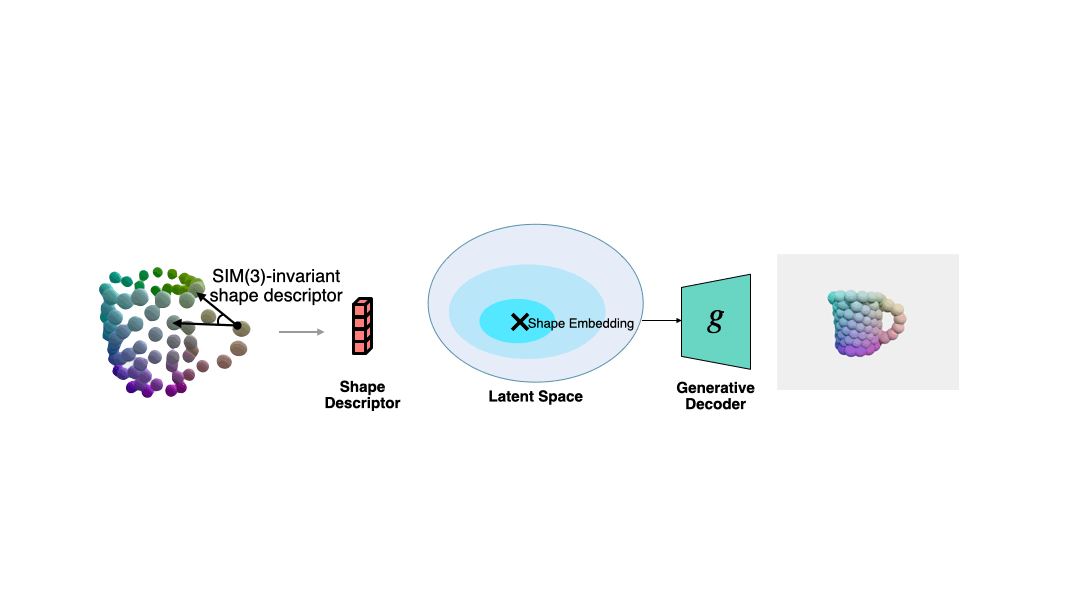
The author also shows more shape optimization examples.

Pose estimation
Finally, by observing the point cloud and solving the semantic origin between the shapes Based on the language correspondence, the author uses the Umeyama algorithm to solve the pose of the observed shape.
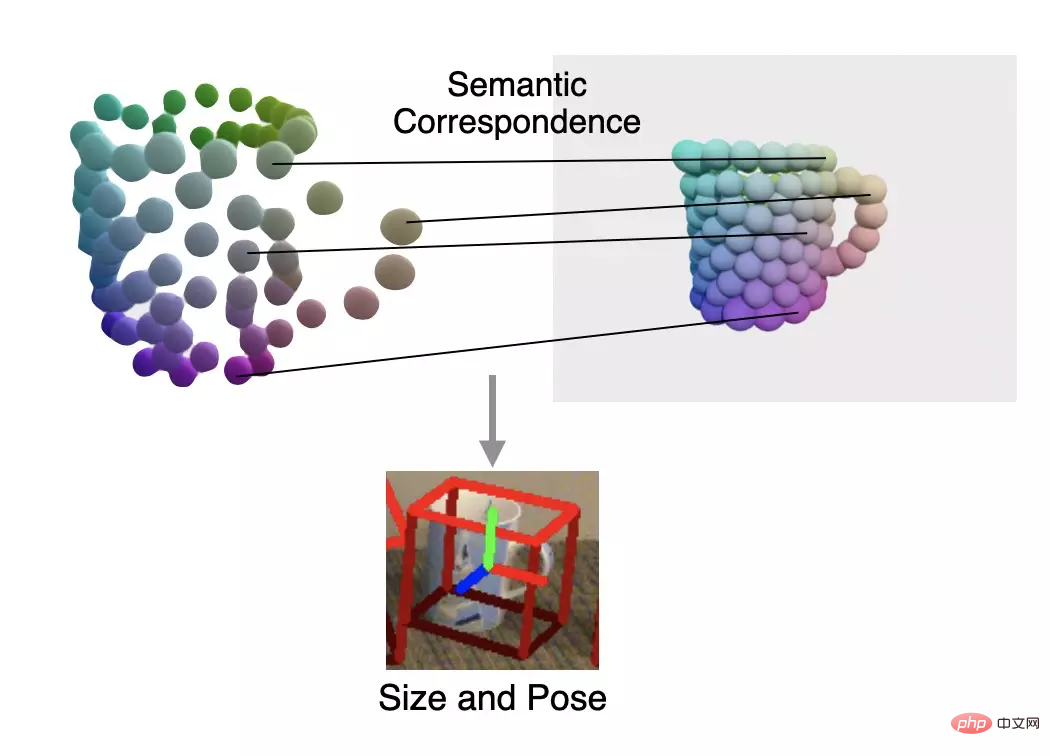
Experimental results
The author is on the REAL275 (real data set) and CAMERA25 (synthetic data set) data sets provided by NOCS Comparative experiments were conducted to compare the pose estimation accuracy with other methods. The proposed method far exceeded other methods in multiple indicators.
At the same time, the author also compared the amount of parameters that need to be trained on the training set provided by NOCS. The author requires a minimum of 2.3M parameters to reach the state-of-the-art level.
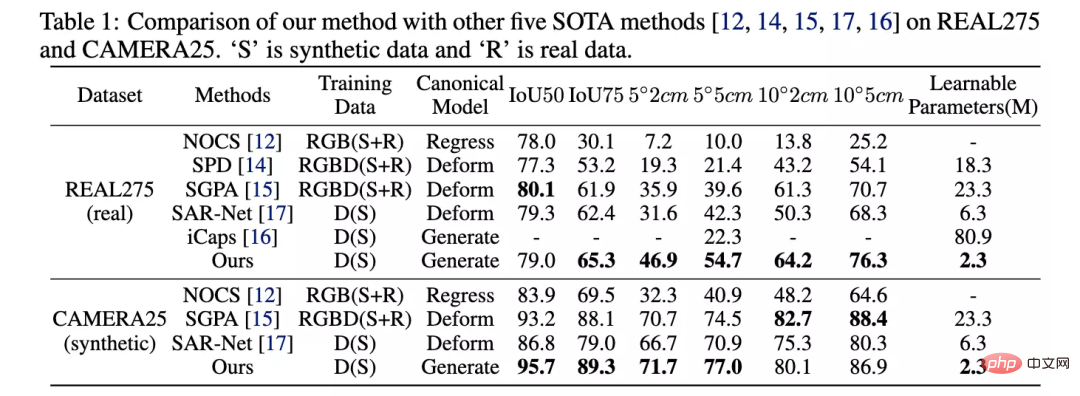
The above is the detailed content of Only 10% of the parameters are needed to surpass SOTA! Zhejiang University, Byte, and Hong Kong Chinese jointly proposed a new framework for the 'category-level pose estimation' task. For more information, please follow other related articles on the PHP Chinese website!

Hot AI Tools

Undresser.AI Undress
AI-powered app for creating realistic nude photos

AI Clothes Remover
Online AI tool for removing clothes from photos.

Undress AI Tool
Undress images for free

Clothoff.io
AI clothes remover

Video Face Swap
Swap faces in any video effortlessly with our completely free AI face swap tool!

Hot Article

Hot Tools

Notepad++7.3.1
Easy-to-use and free code editor

SublimeText3 Chinese version
Chinese version, very easy to use

Zend Studio 13.0.1
Powerful PHP integrated development environment

Dreamweaver CS6
Visual web development tools

SublimeText3 Mac version
God-level code editing software (SublimeText3)

Hot Topics
 1386
1386
 52
52
 The world's most powerful open source MoE model is here, with Chinese capabilities comparable to GPT-4, and the price is only nearly one percent of GPT-4-Turbo
May 07, 2024 pm 04:13 PM
The world's most powerful open source MoE model is here, with Chinese capabilities comparable to GPT-4, and the price is only nearly one percent of GPT-4-Turbo
May 07, 2024 pm 04:13 PM
Imagine an artificial intelligence model that not only has the ability to surpass traditional computing, but also achieves more efficient performance at a lower cost. This is not science fiction, DeepSeek-V2[1], the world’s most powerful open source MoE model is here. DeepSeek-V2 is a powerful mixture of experts (MoE) language model with the characteristics of economical training and efficient inference. It consists of 236B parameters, 21B of which are used to activate each marker. Compared with DeepSeek67B, DeepSeek-V2 has stronger performance, while saving 42.5% of training costs, reducing KV cache by 93.3%, and increasing the maximum generation throughput to 5.76 times. DeepSeek is a company exploring general artificial intelligence
 AI subverts mathematical research! Fields Medal winner and Chinese-American mathematician led 11 top-ranked papers | Liked by Terence Tao
Apr 09, 2024 am 11:52 AM
AI subverts mathematical research! Fields Medal winner and Chinese-American mathematician led 11 top-ranked papers | Liked by Terence Tao
Apr 09, 2024 am 11:52 AM
AI is indeed changing mathematics. Recently, Tao Zhexuan, who has been paying close attention to this issue, forwarded the latest issue of "Bulletin of the American Mathematical Society" (Bulletin of the American Mathematical Society). Focusing on the topic "Will machines change mathematics?", many mathematicians expressed their opinions. The whole process was full of sparks, hardcore and exciting. The author has a strong lineup, including Fields Medal winner Akshay Venkatesh, Chinese mathematician Zheng Lejun, NYU computer scientist Ernest Davis and many other well-known scholars in the industry. The world of AI has changed dramatically. You know, many of these articles were submitted a year ago.
 Google is ecstatic: JAX performance surpasses Pytorch and TensorFlow! It may become the fastest choice for GPU inference training
Apr 01, 2024 pm 07:46 PM
Google is ecstatic: JAX performance surpasses Pytorch and TensorFlow! It may become the fastest choice for GPU inference training
Apr 01, 2024 pm 07:46 PM
The performance of JAX, promoted by Google, has surpassed that of Pytorch and TensorFlow in recent benchmark tests, ranking first in 7 indicators. And the test was not done on the TPU with the best JAX performance. Although among developers, Pytorch is still more popular than Tensorflow. But in the future, perhaps more large models will be trained and run based on the JAX platform. Models Recently, the Keras team benchmarked three backends (TensorFlow, JAX, PyTorch) with the native PyTorch implementation and Keras2 with TensorFlow. First, they select a set of mainstream
 Hello, electric Atlas! Boston Dynamics robot comes back to life, 180-degree weird moves scare Musk
Apr 18, 2024 pm 07:58 PM
Hello, electric Atlas! Boston Dynamics robot comes back to life, 180-degree weird moves scare Musk
Apr 18, 2024 pm 07:58 PM
Boston Dynamics Atlas officially enters the era of electric robots! Yesterday, the hydraulic Atlas just "tearfully" withdrew from the stage of history. Today, Boston Dynamics announced that the electric Atlas is on the job. It seems that in the field of commercial humanoid robots, Boston Dynamics is determined to compete with Tesla. After the new video was released, it had already been viewed by more than one million people in just ten hours. The old people leave and new roles appear. This is a historical necessity. There is no doubt that this year is the explosive year of humanoid robots. Netizens commented: The advancement of robots has made this year's opening ceremony look like a human, and the degree of freedom is far greater than that of humans. But is this really not a horror movie? At the beginning of the video, Atlas is lying calmly on the ground, seemingly on his back. What follows is jaw-dropping
 KAN, which replaces MLP, has been extended to convolution by open source projects
Jun 01, 2024 pm 10:03 PM
KAN, which replaces MLP, has been extended to convolution by open source projects
Jun 01, 2024 pm 10:03 PM
Earlier this month, researchers from MIT and other institutions proposed a very promising alternative to MLP - KAN. KAN outperforms MLP in terms of accuracy and interpretability. And it can outperform MLP running with a larger number of parameters with a very small number of parameters. For example, the authors stated that they used KAN to reproduce DeepMind's results with a smaller network and a higher degree of automation. Specifically, DeepMind's MLP has about 300,000 parameters, while KAN only has about 200 parameters. KAN has a strong mathematical foundation like MLP. MLP is based on the universal approximation theorem, while KAN is based on the Kolmogorov-Arnold representation theorem. As shown in the figure below, KAN has
 Tesla robots work in factories, Musk: The degree of freedom of hands will reach 22 this year!
May 06, 2024 pm 04:13 PM
Tesla robots work in factories, Musk: The degree of freedom of hands will reach 22 this year!
May 06, 2024 pm 04:13 PM
The latest video of Tesla's robot Optimus is released, and it can already work in the factory. At normal speed, it sorts batteries (Tesla's 4680 batteries) like this: The official also released what it looks like at 20x speed - on a small "workstation", picking and picking and picking: This time it is released One of the highlights of the video is that Optimus completes this work in the factory, completely autonomously, without human intervention throughout the process. And from the perspective of Optimus, it can also pick up and place the crooked battery, focusing on automatic error correction: Regarding Optimus's hand, NVIDIA scientist Jim Fan gave a high evaluation: Optimus's hand is the world's five-fingered robot. One of the most dexterous. Its hands are not only tactile
 FisheyeDetNet: the first target detection algorithm based on fisheye camera
Apr 26, 2024 am 11:37 AM
FisheyeDetNet: the first target detection algorithm based on fisheye camera
Apr 26, 2024 am 11:37 AM
Target detection is a relatively mature problem in autonomous driving systems, among which pedestrian detection is one of the earliest algorithms to be deployed. Very comprehensive research has been carried out in most papers. However, distance perception using fisheye cameras for surround view is relatively less studied. Due to large radial distortion, standard bounding box representation is difficult to implement in fisheye cameras. To alleviate the above description, we explore extended bounding box, ellipse, and general polygon designs into polar/angular representations and define an instance segmentation mIOU metric to analyze these representations. The proposed model fisheyeDetNet with polygonal shape outperforms other models and simultaneously achieves 49.5% mAP on the Valeo fisheye camera dataset for autonomous driving
 The latest from Oxford University! Mickey: 2D image matching in 3D SOTA! (CVPR\'24)
Apr 23, 2024 pm 01:20 PM
The latest from Oxford University! Mickey: 2D image matching in 3D SOTA! (CVPR\'24)
Apr 23, 2024 pm 01:20 PM
Project link written in front: https://nianticlabs.github.io/mickey/ Given two pictures, the camera pose between them can be estimated by establishing the correspondence between the pictures. Typically, these correspondences are 2D to 2D, and our estimated poses are scale-indeterminate. Some applications, such as instant augmented reality anytime, anywhere, require pose estimation of scale metrics, so they rely on external depth estimators to recover scale. This paper proposes MicKey, a keypoint matching process capable of predicting metric correspondences in 3D camera space. By learning 3D coordinate matching across images, we are able to infer metric relative



